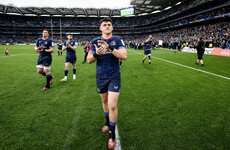THE JURY AT the inquests into the 1989 Hillsborough disaster today provided justice for the 96 football fans who lost their lives that day by ruling not only that they were unlawfully killed but that their behaviour did not cause or contribute to their death.
But why did it take so long? Here are the key dates in the worst disaster in the history of British sport:
15 April 1989: At the start of an FA Cup semi-final between Liverpool and Nottingham Forest at Hillsborough in Sheffield, northern England, a crush of supporters against the steel fences at the Leppings Lane end of the stadium leads to the deaths of 94 Liverpool fans and leaves 766 injured.
April 1989: Days after the disaster, tabloid newspaper The Sun publishes a front-page story headlined ‘The Truth’, saying drunk Liverpool fans were to blame, prompting a mass boycott of the paper on Merseyside. Fourteen-year-old Lee Nicol, who was on life support, dies, taking the death toll to 95.
August 1989: An interim report by leading judge Lord Justice Peter Taylor says police were at fault for failing to close off a tunnel leading to pens for supporters, failing to control the build-up of fans outside the stadium and their slow reaction to the tragedy.
He criticises Chief Superintendent David Duckenfield, the senior policeman at the game, for “failing to take effective control” and South Yorkshire Police, which blamed supporters for arriving at the ground “late and drunk”.
January 1990: Taylor’s full report recommends the removal of terrace fences and the introduction of all-seater stadiums.
April 1990: An inquest into the victims’ deaths begins, heard by coroner Dr Stefan Popper.
August 1990: Britain’s Director of Public Prosecutions finds there is insufficient evidence to bring criminal charges against the police or any other individual, group or body.
March 1991: Popper’s inquest into the deaths returns verdicts of accidental death for all the victims, ruling that they were all dead by 3:15 pm.
March 1993: Tony Bland, 22, becomes the 96th and final victim of the tragedy when he is taken off life support after four years in a persistent vegetative state.
June 1997: Home Secretary Jack Straw orders evidence to be re-scrutinised.
August 1998: After Straw rules out a new inquiry, the Hillsborough Family Support Group brings private manslaughter charges against Duckenfield and his deputy, Superintendent Bernard Murray.
July 2000: Following a six-week trial, a jury finds Murray not guilty of manslaughter and fails to reach a verdict on Duckenfield. The judge refuses a retrial, saying that a fair trial for Duckenfield would be impossible.
April 2009: The Hillsborough Independent Panel is set up in the wake of the 20th anniversary of the tragedy.
October 2011: British lawmakers agree that all government papers should be handed over to the independent panel.
September 2012: The report of the Hillsborough Independent Panel finds police orchestrated a cover-up, falsified documents and blamed innocent supporters.
It says the lives of 41 fans could have been saved and clears supporters of any wrongdoing or blame for the disaster, prompting a public apology from Prime Minster David Cameron.
Kelvin MacKenzie, editor of The Sun at the time of the tragedy, offers “profuse apologies” for the paper’s notorious front page.
October 2012: The Independent Police Complaints Commission watchdog and Director of Public Prosecutions announce they will both launch inquiries into possible crimes committed by police involved in the disaster.
December 2012: Following the cover-up revelations, London’s High Court quashes the original coroner’s verdicts of accidental death.
March 2014: Fresh inquests into the deaths begin at a purpose-built courtroom in Warrington, east of Liverpool, with families of the 96 victims in attendance.
January 2016: After 267 days of evidence — the longest case heard by a jury in British legal history — from over 800 witnesses, coroner John Goldring begins his summing up.
6 April 2016: Jury retires to consider its verdict.
26 April 2016: The jury finds that the 96 fans were unlawfully killed and that their behaviour did not cause or contribute to the disaster.
Additional reporting by Steve O’Rourke.

















No need to risk Furlong this Sat, hamstring injures are volatile. Bealham and Healy (for his cap record), then Clarkson and O’Toole on the bench (time to properly test the TOT at LHP idea, + Porter really needs a rest). Poor Baird, last season was fantastic but he cannot get going this season.
@Andrew Slazenger: if you don’t test it this Saturday no point in starting him against Australia next week either
@Andrew Slazenger: i would go Boyle at LH back up – hes quality
How about Tom Aherne on a like for like basis for Baird ? Wild card, I admit ….
@Laup Ekrub: he’s not in the squad and if not baird it’s pendergast or izzy both in the camp and both in great form. Aherne has injured and needs a run of quality games before he makes the Irish squad.
@Laup Ekrub: Has he being called up
@Laup Ekrub: he’s been poor so far this season
@Laup Ekrub: It has to be Izzuchukwu on a like for like basis, Paul Burke (or is it Pual). Ahern is not in the squad so he would not have been part of the meetings or training sessions so far this autumn. He will get his chance
@Paul , you nailed it in one !
@Max: it’s a bit of wishful thinking although I see similarities between both players – time will tell
@anthony davoren: Really? Do expand, with detailed evidence.
Frawley to start and SP to get 30mins
Izzy Ur time is now
That is good news and for Leinster too – they will need Clarkson back for that tricky interpro on the Australia weekend. But I still have memories of an under-developed wonderkid Joey Carbery being smashed by Fiji in a corresponding fixture and the career setback that was for him, and wonder if this is the right game for Sam to start, given his as yet slender(ish) physique?
@John Morris: Should probably give Frawley a chance to redeem himself with Crowley on the bench. Prendergast has plenty of time on his side. Another year’s S and C will hopefully have him physically ready for top class rugby.
@John Morris: the setback for carberry was being persistently injured and not even recurring ones. He just wasn’t durable enough in general. Di t think it was one game that ruined him
@TL55: I agree I’d like Fawley to get a start to rebuild his confidence, otherwise a bit harsh given that he had one bad day at the office
@Ronnie C: wouldn’t be surprised if Frawley starts with Casey and Crowley is on the bench with JGP. Sam has nothing to prove in terms of skill set and probably match temperament- but he needs protection as he grows into that 6’4” height- which is VERY tall for an outhalf in the modern game and making him an upright target. Most of the other out halves lighting up the game at the moment are about 10cm shorter- which is a lot. Jim Hamilton is suggesting he needs another 5-6kg for his height and that seems sensible.
@John Morris: rugby pod
@Gary Galligan: pod pod pod
@John Morris: I still remember that tackle , he was never the same after ! Probably why I’d go Frawley over SP
@John Morris: Barrett is hardly that much shorter. Sexton wasn’t, Healy isn’t, frawley isn’t. Most kids that that are backs that look like they’ll end up tall get moved to back 3. Yes, he’s an upright target but he’s always been. And most 21 year olds naturally have a bit to fill out.
@Ciaran Kennedy: .. only Barrett and Sexton from your list proven at elite level and Sam has 2-3 inches on them. And Frawley lost a lot of his mobility and skill bulking up. All the greats have been 6’ or less – Dan Carter, Jonny W etc and now all 3 French 10s, Marcus Smith, Caleb Muntz , Damian McKenzie, Richie Mo’unga .. surely there is a pattern there regarding the needs of the position?
Keep furlong ready for the aussies
@Shawn: probably needs some game time. In the bench?
@PatN: Agreed. 20-25 minutes off the bench. To facilitate that we need Bealham to start imo as we don’t want to have to bring him on early if one of the less experienced players are being taken to the cleaners
@PatN: if fit for sure just listening to rugby weekly extra bernard jackman has me worrired why do all countriies now hate ireland must be jealousy
@Shawn: Jealousy is a horrible trait Shawn.
@Shawn: a lot NZ’ers are total A wholes in my experience
@Shawn: it is because many have become haughty overbearing pri@ks. Witness the reaction to the last 2 Irish performances in this platform. Beat Arg and lose narrowly to AB yet scathing posts . Read G Thornley in Irish Times today- he wonders where all this entitlement came from, remarking that it doesn’t suit us. I agree wholeheartedly.
@Michael Corkery: the scrum halve did u hear what he said about crowley
@JJB: Yes but we are winning side now lots want us to lose now they can all f.. o.. sorry my spainsh
@Ray Ridge: To be sure
@Shawn: it’s just saffas and kiwis not liking any other nation being talked about as a top side. Some of the irish media love to talk it up, then ireland failing at rwc means we’re gonna get hammered by other fans.
@Patrick O’Sullivan: I shout for england now over SA cant stand their fans not all off course but most
Clarkson has risen in the pecking order
Hoping the average age of the match day squad is a good bit below 30 this weekend!!
Even as a Munster fan I’m hoping Crowley sits this one out. Start one of the others as it will put pressure on Cullen to play him more.
Carberry scored an early cheeky try
thereby making himself target for the day — SP is not that sort of outhalf
I would change the back 3 front row and back row
The mid field centres have yet to show a positive contribution in attack and therefore need game time .
The normal XV lads can sit on the bench for impact (?)
If Ireland woundn’t use C.Prendergast this week, it should make him to go back Galway at once, and he should prepare against Bulls game.